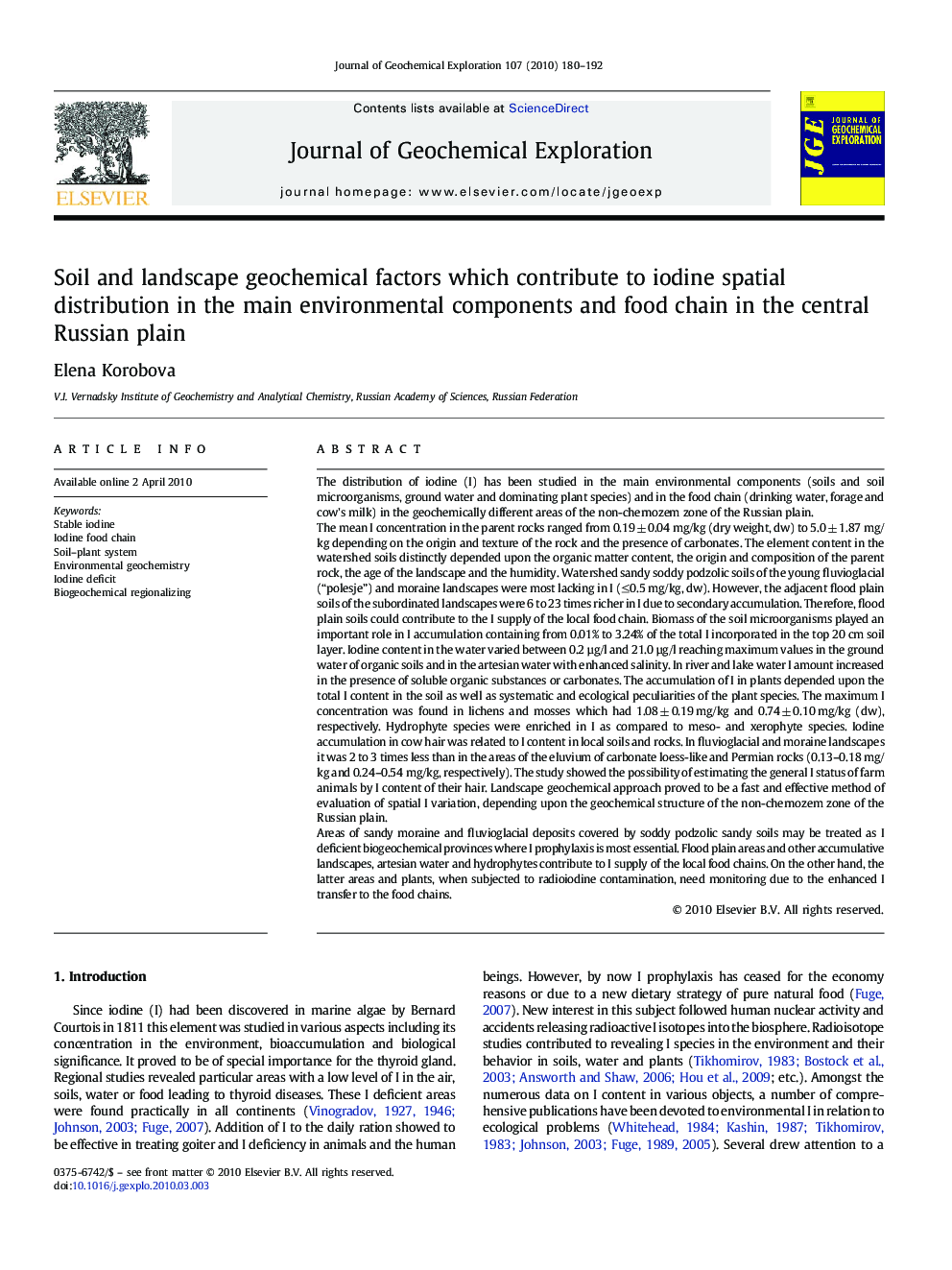| کد مقاله | کد نشریه | سال انتشار | مقاله انگلیسی | نسخه تمام متن |
|---|---|---|---|---|
| 4457965 | 1312645 | 2010 | 13 صفحه PDF | دانلود رایگان |

The distribution of iodine (Ι) has been studied in the main environmental components (soils and soil microorganisms, ground water and dominating plant species) and in the food chain (drinking water, forage and cow's milk) in the geochemically different areas of the non-chernozem zone of the Russian plain.The mean I concentration in the parent rocks ranged from 0.19 ± 0.04 mg/kg (dry weight, dw) to 5.0 ± 1.87 mg/kg depending on the origin and texture of the rock and the presence of carbonates. The element content in the watershed soils distinctly depended upon the organic matter content, the origin and composition of the parent rock, the age of the landscape and the humidity. Watershed sandy soddy podzolic soils of the young fluvioglacial (“polesje”) and moraine landscapes were most lacking in I (≤0.5 mg/kg, dw). However, the adjacent flood plain soils of the subordinated landscapes were 6 to 23 times richer in I due to secondary accumulation. Therefore, flood plain soils could contribute to the I supply of the local food chain. Biomass of the soil microorganisms played an important role in I accumulation containing from 0.01% to 3.24% of the total I incorporated in the top 20 cm soil layer. Iodine content in the water varied between 0.2 µg/l and 21.0 µg/l reaching maximum values in the ground water of organic soils and in the artesian water with enhanced salinity. In river and lake water I amount increased in the presence of soluble organic substances or carbonates. The accumulation of I in plants depended upon the total I content in the soil as well as systematic and ecological peculiarities of the plant species. The maximum I concentration was found in lichens and mosses which had 1.08 ± 0.19 mg/kg and 0.74 ± 0.10 mg/kg (dw), respectively. Hydrophyte species were enriched in I as compared to meso- and xerophyte species. Iodine accumulation in cow hair was related to I content in local soils and rocks. In fluvioglacial and moraine landscapes it was 2 to 3 times less than in the areas of the eluvium of carbonate loess-like and Permian rocks (0.13–0.18 mg/kg and 0.24–0.54 mg/kg, respectively). The study showed the possibility of estimating the general I status of farm animals by I content of their hair. Landscape geochemical approach proved to be a fast and effective method of evaluation of spatial I variation, depending upon the geochemical structure of the non-chernozem zone of the Russian plain.Areas of sandy moraine and fluvioglacial deposits covered by soddy podzolic sandy soils may be treated as I deficient biogeochemical provinces where I prophylaxis is most essential. Flood plain areas and other accumulative landscapes, artesian water and hydrophytes contribute to I supply of the local food chains. On the other hand, the latter areas and plants, when subjected to radioiodine contamination, need monitoring due to the enhanced I transfer to the food chains.
Journal: Journal of Geochemical Exploration - Volume 107, Issue 2, November 2010, Pages 180–192